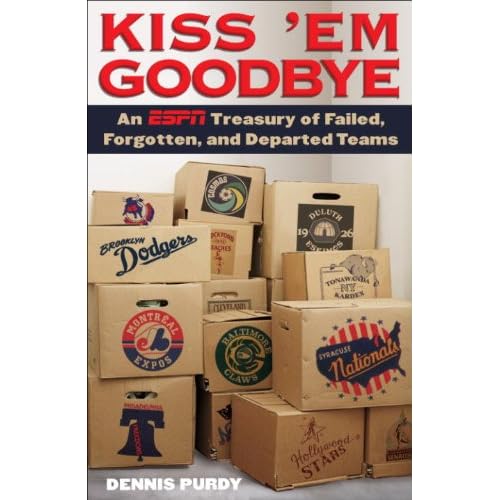
Proof, if any were needed, that my wife's a keeper: she got me this book for Valentine's Day. Y'all read that and weep, fellows: my lady bought me a sports book for that most Hallmarky of Hallmark holidays. And a box of sea salt caramels from The Chocolate Fetish in Asheville; that, too.
What Dennis Purdy has done is compile the stories of something like eighty teams that have closed down, from a wide variety of sports. It's one heck of a fun idea, but I say that from the perspective of somebody who has nostalgic fascination about those elements of the past that only exist in photos and memorabilia. Just five years ago, the kids and I got together with my buddy Matt and drove to Macon to see two teams that no longer exist, in a league that folded last year. The names "Macon Knights" and "Wilkes-Barre/Scranton Pioneers" mean more to me than the name of the girl who rode down there with us.
Conceptually, the book is a great idea, and many of the entries were really fun to read. I enjoyed the stories of the NASL's New York Cosmos and the PCL's Hollywood Stars a lot, along with everything related to the American Basketball Association. I love the ABA. I'm not sure what I would enjoy more, watching the Hawks host the Cavaliers for a night to see Joe Johnson and LeBron James play against each other, or taking a time-traveling trip to 1975 to see any two ABA teams play, just to say I did. And possibly get supper at a Hungry Fisherman while I was back then.
The book does have a major flaw in that Purdy seems to expect a pretty intensive knowledge base from his readers. I understood from his introductions that the author knows more about baseball in the 1890s than practically anybody, and perhaps there's a great deal that's entertaining about the turn-of-that-century shenanigans that saw men with handlebar mustaches eventually forming the present-day Major League from the ashes of what seems like two dozen regional associations with assorted ownership struggles. Lacking the background, however, I was completely lost whenever any of these New York Knickerbocker-era teams turned up in the narrative. Since the book is listed in alphabetical order of the teams' cities, and since old-timey baseball and similarly antediluvian football teams from the NFL's archaeology make up the bulk of the book, it was very easy to get confused, and, frankly, bored.
What would have made this a much more fun read would have been to organize the stories by sport and detail them chronologically, taking time out for more extensive histories of particularly notable or colorful teams. Frankly, no reader should have to consult Wikipedia to understand the distinctions between the National Association, the National League, the Union Association and the Players Association when there's a 360-page book in front of them that could have taken the time to lay it out chronologically.
The stories from the 1950s onward are much easier to follow, and there really are some wild and funny tales about teams that were doomed from the outset, or beset with fires, floods or owners literally moving them out of town in the middle of the night. I can totally understand lots of people in Baltimore still spitting fire about what happened to the Colts, especially since I met a fellow three years ago who is still cheesed off that the Kentucky Colonels didn't make it to the NBA.
There are great stories here, but I'm just not satisfied that this book told them as well as it might. I'd certainly love to see a second edition one day, where the frustration factor never overwhelms my genuine curiosity. Recommended with reservations.
No comments:
Post a Comment